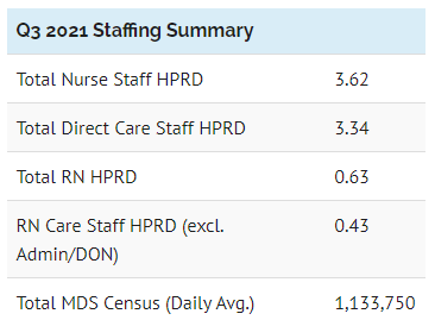Mary Madison, RN, RAC-CT, CDP
Clinical Consultant – Briggs Healthcare
LTCCC (Long Term Care Community Coalition) posted this alert on March 3, 2022:
“Federal requirements mandate that nursing homes have sufficient staff, with the appropriate competencies to meet the clinical, emotional, and psychosocial needs of every resident. Unfortunately, understaffing is a widespread and persistent problem that has only become worse since the start of the COVID-19 pandemic.
Today, LTCCC announces the publication of the latest staffing data for every U.S. nursing home (in compliance with mandatory reporting requirements) during the third quarter of 2021. The federal data show that staffing levels (3.62 Total Nurse Staff HPRD, incl. 0.63 RN Staff HPRD) are declining as too many facilities continue failing to provide basic care needs for far too many of the nation’s 1.1 million nursing home residents. Residents, families, and U.S. taxpayers are paying the price.
Staffing Facts for Q3 2021
- Nursing homes averaged 3.62 Total Nurse Staff hours per resident day (HPRD), including 0.63 Total RN HPRD, falling well below the minimum staffing threshold (4.10 total care staff HPRD, 0.75 RN HPRD) indicated by a landmark 2001 federal study.
- Staffing levels have dropped 7.8% since the first quarter of 2021 while resident census has climbed 5.1% during that same period. This indicates that too many nursing homes are admitting new residents even when they lack adequate staffing to meet their basic needs.
- Total RN Staff HPRD (0.63) has dropped 9.3% since Q1 2021.
- More than 70% of U.S. nursing homes failed to meet the total care staff threshold (4.10 HPRD) as determined by the 2001 federal study.
- Contract staff accounted for 7.1% of all nurse staff hours in Q3 2021, increasing from 5.0% in Q1 2021.
- Average total resident census rebounded to 1.13 million, up 2.5% from the previous quarter and 5.5% since Q1 2021.
LTCCC’s Q3 2021 report can help the public, media, and policymakers identify and assess the extent to which nursing homes in their communities provided sufficient staffing to meet basic clinical and quality of life needs. The report is based on the most recent payroll-based journal (PBJ) data reported by the federal Centers for Medicare & Medicaid Services (CMS). (See: PBJ Daily Nurse Staffing and PBJ Daily Non-Nurse Staffing). Visit the NursingHome411 Data Center for more information on staffing, five-star ratings, and other important nursing home data.
Note: Nursing staff turnover rates and weekend staffing levels are now available for individual nursing homes on the federal Care Compare website. These figures are not included in our report since they are not, yet, being published in the federal database.”
The Nursing Home Staffing Q3 2021 report is found here.
LTCCC’s Q3 2021 Staffing Report provides user-friendly files for every state that contain facility-level data on: 1) Nurse staff levels (RN, LPN, and CNA, including Admin & DON, NA in Training, Med Aide/Tech.); 2) Important non-nursing staff levels, including administrators and activities staff; 3) Contract workers. 4) Summary staffing data at the state, CMS region, and national levels.
The Summary Data is also found on this spreadsheet.

Not familiar with LTCCC?
“The Long Term Care Community Coalition (LTCCC) is a nonprofit organization dedicated to improving quality of care, quality of life, and dignity for elderly and disabled people in nursing homes, assisted living, and other residential settings.
LTCCC focuses on systemic advocacy, researching national and state policies, laws, and regulations in order to identify relevant issues and develop meaningful recommendations to improve quality, efficiency, and accountability. In addition to providing a foundation for advocacy, LTCCC uses this research and the resulting recommendations to educate policymakers, consumers, and the general public. Consumer, family, and LTC ombudsman empowerment are fundamental to our mission.
LTCCC’s work is grounded in its organization as a New York State based coalition of consumer, community, civic, and professional organizations, bringing together these different stakeholders to identify and address the systemic issues that affect quality of care and dignity in long-term care.”
CMS is hosting a National NH Stakeholder Call this afternoon (March 10th) at 3pm ET. You’ll find the link to register for the call within this blog. I encourage you to attend if possible. The call will also be recorded for on-demand viewing as well.
